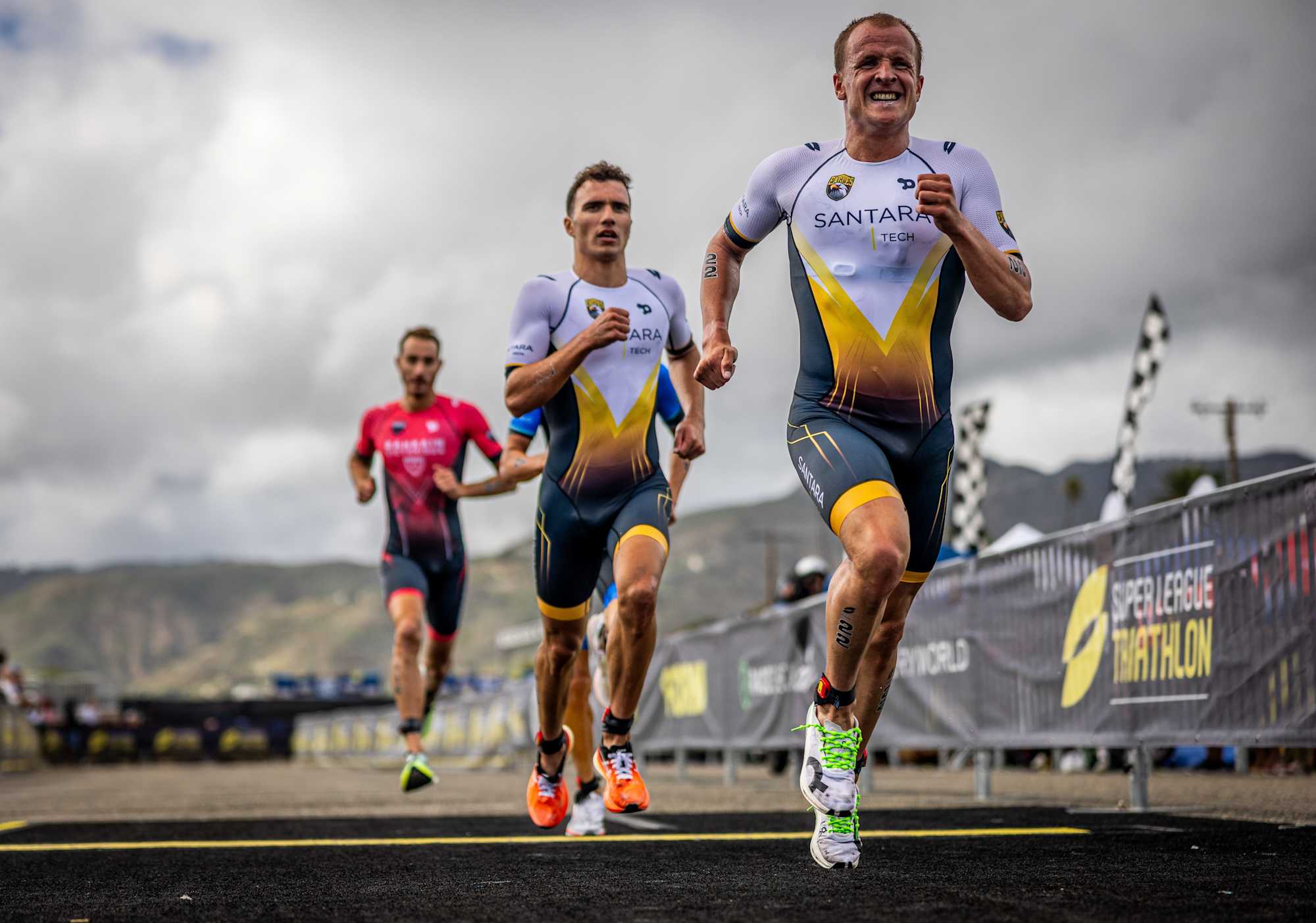Triathlon distances: IRONMAN, Olympic, sprint, super sprint & super league

Triathlon is a mixture of three sports – swim, bike and run – and triathlon distances vary.
Shorter races can take less than an hour to complete, but events can take up to 17 hours and sometimes even longer.
In this guide we’ll have a look at the most common triathlon distances available. While it might make sense for beginners to start with the shorter distances and work their way up, that’s not everybody’s approach.
RACE TYPE | SWIM | BIKE | RUN | TOTAL |
Ironman | 2.4m / 3.8km | 112m / 180km | 26.2 m / 42.2km | 140.6m / 226km |
Half Ironman / 70.3 | 1.2m / 1.9km | 56m /90km | 13.1m / 21.1km | 70.3m / 113km |
World Triathlon/ITU long Course | 2km | 80km | 20km | 102km |
Olympic | 1.5km | 40km | 10km | 51.5km |
Sprint | 750m | 20km | 5km | 25.75km |
Super Sprint | 400m | 10km | 2.5km | 12.9km |
Super League | 300m x3 | 4km x3 | 1.6km x3 | 17.7km |
Arena Games Triathlon | 200m x3 | 3km x3 | 1km x3 | 12.6km |
WHAT ARE THE DIFFERENT TRIATHLON DISTANCES?
In theory, a triathlon can be completed over any distance. Some of the most iconic triathlon events in the world, such as the Alpe d’Huez Triathlon, have bespoke lengths. This is usually to fit the terrain the triathletes are racing – such as a huge mountain in South East France.
But standardised distances for events such as Ironman and the Olympics are more common. Most triathlons will try to align their own course lengths to these more familiar endurance tests.
While distance can be a good guide to see how challenging a race might be, it isn’t everything. It’s also worth looking at the course profile and the likely conditions you’ll face. For example, a 30km hilly bike ride in a hot and humid climate can often be a lot more taxing than 40km on smooth tarmac in a pleasant 20 degrees.
With all this in mind, let’s look at the most popular distances in turn – starting with the longest.
IRONMAN TRIATHLON
The behemoth of triathlon. Raced over a 2.4mile (3.8km) swim, 112mile (180km) bike and 26.2mile (42.2km) run, Ironman started on the Hawaiian island of Oahu in 1978, as a bet between swimmers, cyclists and runners to see who was fitter. It’s now become a global phenomenon with M-Dot events all over the world, and tattoos all over triathletes’ calves.
Ironman is a brand, but other independent companies put on iron distance (or full distance) events. The fastest times over this distance were both set at Challenge Roth in Germany. 8hr 18min 13 sec from Brit Chrissie Wellington in 2011, and 7hr 35min 39sec from Germany’s Jan Frodeno in 2016.
Mere mortals normally go a little slower though. The bell curve of finishers tends to peak around the 12-14hr mark. Ironman events also have a strict cut-off, often 17hrs, that triathletes have to beat to hear the announcer bellow: “YOU ARE AN IRONMAN!”
Despite its magnitude, Ironman isn’t actually the longest triathlon you’ll find. ‘Ultra’ triathlon distances include, double, triple and quad iron distance events, all the way up to a deca and even double deca – the latter being 20 iron distance races in 20 days or a continuous and mindboggling 48mile swim, 2,240mile cycle and 524mile run.
HALF IRONMAN / IRONMAN 70.3
The Ironman 70.3, also known as the half iron distance or middle distance, is an increasingly popular challenge among triathletes and has expanded to much that there are now more options to race the middle distance than there are to tackle the full Ironman.
As with Ironman, Ironman 70.3 is a trademark. 70.3 stands for the total distance covered in miles during the event. It’s comprised of a 1.2mile (1.9km) swim, 56mile (90km) bike and 13.1mile (21.1km) run. Exactly half the length of an Ironman.
The first Ironman 70.3 World Championship took place in 2006 in Florida, but such is the growing demand, it now rotates annually to different locations in the world. The event is split over two days, with the women racing on the Saturday and men on Sunday and draws in around 6,000 qualified competitors.
What sort of time should you aim for? As mentioned previously, a lot depends on how testing the course, but the best male professionals finish in around 3hrs 45mins and the women around 4hrs. Age-groupers will cross the line in the hours that follow. As with the full distance, there is usually a cut-off time, often around 9hrs.
OLYMPIC DISTANCE TRIATHLON
This is perhaps the most well known triathlon distance. If you’ve ever watched triathlon at the Olympics Games, you’ll have seen the triathletes compete over the Olympic or standard distance of a 1.5km swim, 40km bike and 10km run. This distance has been instilled since the International Triathlon Union, now World Triathlon, started its first world championship, in France, in 1989.
While on TV, you might see competitors in packs on the bike, however standard distance racing is non-drafting for amateur athletes. Non-drafting means you’re not allowed to be in the slipstream of the cyclist you’re following for too long. It’s a rule designed to make a fairer and safer way of racing.
While professional men racing the draft-legal format might complete a course in 1hr 45min, and the women in under 2hrs, a good level age-group triathlete can take around 2hr 30min. Novices completing the distance can often finish around 3 ½ – 4hrs. Comparing endurance events is hard, but an athlete who has completed a marathon, is likely to find the effort to complete a standard distance triathlon is slightly less – although there will be far more things to think about on the way!
The Olympic or standard distance is still the staple distance of the World Triathlon Championship Series (WTCS). This is the highest level of elite competition with the series typically running from the northern hemisphere spring to autumn and consisting of six-to-eight races culminating in a Grand Final. However, in recent years, more of the WTCS races have become sprint distance and World Triathlon is also starting to experiment with other formats.
SPRINT TRIATHLON
Another popular triathlon distance, the sprint format covers half that of the Olympic distance. Only in an endurance sport like triathlon would this be called a ‘sprint’. The race is still held over a 750m swim, 20km bike and 5km run. Sprint racing shouldn’t be taken lightly. Raced hard, it can be as tiring as a standard distance event.
As with the longer distances, the swim on a sprint triathlon is typically in a lake, sea or river. It’s also the distance of choice for elite juniors until they reach under-23 level, and there have been calls for the sprint distance to replace the standard distance in Olympic competition. Competitive amateurs might also find that sprint races they enter are now draft-legal, so will need to be comfortable riding with other cyclists in close proximity.
Some events will give the option for a standard/Olympic, sprint or even super sprint distance, which often involves doing a different number of laps of the same course. It can be a great option for a group of triathletes who all want to compete at the same event, but don’t necessarily all want to complete the same distance.
In terms of times, while elite triathletes often finish in under an hour, amateurs tend to be between one and two hours for a sprint triathlon.
SUPER SPRINT TRIATHLON
A super sprint triathlon is the entry-level distance for most triathletes. Typically the race consists of a 400m swim, 10km bike and 2.5km run.
Because of the shorter distance, super sprints often use a swimming pool for the swim – 16 lengths of a 25m pool – before heading out on to the bike course. This makes it more accessible for beginners. There is no need to have a wetsuit, or to worry about swimming in open water.
If the thought of swimming, biking and running these distances is still a little daunting, then there are other options. A duathlon, normally a bike-run, could be a first step into the sport, or even a relay where individuals select one leg of the race each as part of a three-person team.
SUPERTRI
The Super League Triathlon distance is a new, exciting and super short race format. A 200m swim, 4km bike and 1km run. Super League Triathlon is fast and furious, and contested by some of the world’s best short course triathletes including Olympic medal winners and world champions.
The triathletes don’t just race the distance through once, but multiple times with varying combinations of each discipline in each event. The innovative formats used for the pros include the Enduro, Triple Mix, Eliminator and Equalizer. You can find all the latest news from Super League Triathlon here.
SUPERTRI E
The newest format of all, the SLT Arena Games mixes triathlon and e-racing to deliver an innovative and fast-paced indoor competition.
Raced over Super League Triathlon distances, it consists of a 200m swim, a 4km bike leg and a 1km run, completed multiple times and in different orders. The big difference for the SLT Arena Games is that it’s a pool swim, the cycling takes place on the turbo trainer and the run on a self-propelled curved treadmill.
As well as the athletes battling alongside one another in the pool and on the pool deck, the bike and run take place in the virtual world of Zwift, so viewers can also watch their avatars racing head-to-head on the Zwift interface.
FAQS
WHAT TRIATHON DISTANCE SHOULD I TRY AS A BEGINNER?
Common wisdom suggests you should start with shorter distances and work your way up. This will help you learn the sport, hone your skills – such as mounting and dismounting the bike – and start to build up your fitness. Starting with shorter distances also means you won’t need as much kit to get going. For pool swims, for example, you won’t require a wetsuit. Starting with shorter events is normally also kinder on the bank balance. These races tend to be less expensive than Iron distance races. All that said, some novice triathletes have the goal of ultra long distances and bragging rights. It’s not unheard of for a triathlete’s first event to be an Ironman.
HOW MUCH DO TRIATHLON EVENTS COST?
Triathlon is never going to be the cheapest sport. Events take a lot of organising, whether that’s putting in safety measures for the swim, closing down public highways, or just delivering a great race experience to triathletes. It all costs money. However, there is also a wide range of entry prices for races so you should hopefully be able to find something to suit your budget. A rule of thumb is that the further the distance, the more you’ll pay. Branded events, such as Ironman, are also likely to come at a premium.In terms of actual numbers, a super sprint or sprint could start from as low as £40 (even lower if you sign-up for one of the British Triathlon-supported GO TRI taster events). This can rise to in excess of £500 for a branded iron distance event. Early booking can often result in a discount and charity places are also often available for those prepared to raise sponsorship funds.
CAN I DO AN IRONMAN AS MY FIRST TRIATHLON?
It’s unlikely to be recommended by many coaches, but plenty of triathletes are motivated by completing an Ironman. Whenever there’s a show of hands for “your first triathlon” at an iron distance event, there are always a number of raised arms.While it will be a steep learning curve, if you feel it’s for you, the important thing is to be as prepared as possible. Include race simulations into your training, so you can start to understand what the distances might feel like come race day. As well as being able to swim 2.4miles, cycle 112miles and run a marathon, if you’re set on making your first triathlon an Ironman, make sure you have a plan for fuelling too.
HOW TO TRAIN FOR A TRIATHLON?
There are many ways to train for a triathlon, but the important thing is to make sure you have enough practice in each discipline. This way you can be confident you’ll complete your chosen swim, bike and run distances come race day. For beginners starting out, it’s recommended that you give yourself three to four months to train for the event, and try to complete at least two swims, bikes and runs a week.
WHAT DISTANCE IS A MINI TRIATHLON?
If you hear of a mini distance triathlon for adults, then it is probably in relation to a super sprint distance of a 400m swim, 10km cycle and 2.5km run. However, a mini triathlon might also be in relation to youth triathlon. Here the distances start for ages as young as eight with a 50m pool swim, 800m cycle on grass and a 600m run.
WHAT ARE THE AVERAGE TIMES FOR PROFESSIONALS?
Over the Ironman distance the best male professionals are able to finish in under 8hrs and the best women professional under 9hrs. Much depends on the course profile and the conditions on the day. For Ironman 70.3, this can be lowered to 3hrs 45min for men and 4hrs for women, and Olympic distance triathlon male professionals tend to finish around 1 hr 45min and women around 1 hr 55min.
WHAT ARE THE AVERAGE TIMES FOR AMATEURS/AGE GROUPERS?
The average time for an amateur to complete an Ironman race is around 12-14 hrs. There are a number of variables, such as the profile of the course, the weather conditions on the day and the age of the triathlete in question. For the standard or Olympic distance, amateurs might look at 3hrs to complete the distance.







